Scoop: Wabi-Sabi Gardening
Published 8:42 am Friday, September 1, 2017
By Susan Jonas
Garden Club of Danville
One of the hardest things for many gardeners to do is sit back and relax in the garden. Every time I settle down to enjoy the scene, something pops into view that needs doing. The wisteria on the fence is already climbing into a nearby tree again. We just cut it back last month, for Pete’s sake. Weren’t those flowers deadheaded yesterday? That’s the thing about the art of gardening. It’s never finished, always changing, and never exactly the way we imagined.
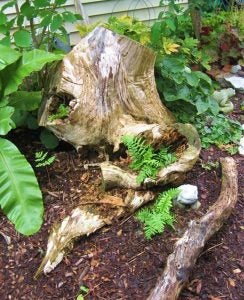
Photo by Susan Jonas.
A silvery gray tree stump minus its bark becomes a piece of sculpture in the garden. This stump was salvaged from a burn pile, hauled home in a wheelbarrow and placed in the garden with ferns planted in its hollows. Wabi-sabi teaches us to savor the beauty in things that are usually ignored or thrown out.
That’s why I’m cultivating the idea of wabi-sabi gardening. Wabi-sabi is the Japanese worldview of accepting transience and imperfection. Gardening is just one aspect of this approach to living. Wabi-sabi acknowledges three simple realities: nothing lasts, nothing is ever finished, and nothing is perfect. Think of it as beauty that is imperfect, impermanent, and incomplete.
By August I’m all for it, and when September rolls around, wabi-sabi is inevitable in my garden. Face it. Things have gone to pot in the heat of summer. I’m tired of tidying the beds, scrubbing birdbaths, and pulling weeds. How do gardeners manage year ‘round in places like Florida and Southern California? By autumn I’m eagerly anticipating dormancy. It’s tempting to leave it a mess and just call it wabi-sabi, but that wouldn’t be correct.
Wabi-sabi is tamed, subdued and serene, but also natural and neat. It’s the opposite of a trim English garden but it’s not messy. Wabi-sabi is a way of imitating natural environments in a cared for garden.
For me, one of wabi-sabi’s attractions is the use of native plants. These indigenous species that adapted over millennia to Kentucky’s soil and climate can take care of themselves and manage to look good without a lot of care and attention. The creative part is deciding where they will thrive and how they’ll interact when arranged in natural-looking sweeps and layers. There’s a fine art to creating a garden that feels close to nature but also offers carefully thought out spots for sitting, with objects that fit naturally in their settings.
Allowing dormant plants to stand over the winter, go to seed and display their seed pods is not only wabi-sabi, it’s also good for the birds and hibernating insects. Leaving a rotting log to decay in the garden lets us watch nature taking its course. Wabi-sabi gardening allows the gardener and the visitor to explore the beautiful ways nature changes both natural and manmade landscapes and objects. It celebrates the cracks and crevices, the broken and faded bits that show nature’s cycles of growth, decay, and erosion.
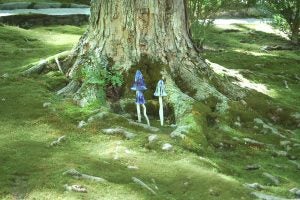
Photo by Andrea Perkins
By enhancing the natural features of their lakeside property, the Garden Club’s Kay Richardson and her husband Phil encouraged a moss lawn that follows the principles of wabi-sabi gardening. The peeling bark of an ancient maple tree with a fern growing from its base, velvety moss, exposed tree roots, and three ceramic mushrooms give their front yard a serene Japanese atmosphere which they find very peaceful.
A garden based on wabi-sabi principles uses both natural and manmade elements in a way that allows viewers to appreciate their humble and imperfect forms. This means the use of not only plants, but also stones, wood, and weathered manmade objects as design elements. Rusted metal, lichen covered rocks, twisted driftwood, and mossy pots are examples of wabi-sabi elements. An algae covered statue that is cracked or chipped is another. Brand new looks raw and artificial.
Pots and statues take on character as they age. Concrete and terra cotta will weather naturally over time, acquiring a beautiful patina of algae, moss, and mineral deposits, but you don’t have to wait for that look. There are many recipes for aging pots, using everything from manure and water to buttermilk, flour, and dry moss.
The Garden Club’s Sarah Wiltsee thinks the simplest method is slathering plain yogurt on a new pot. If you want to, you can also mix moss from your yard into the yogurt, either in a blender or by hand. Set the pot aside in a shady spot, keep it damp, and before long it will look like it’s been in your garden for years.
The next time you’re in your garden, rushing around to finish autumn chores, slow down and observe the beauty in things that are aging, decaying, impermanent and just a bit flawed. Sounds like most of us, doesn’t it?
The Garden Club of Danville meets the first Wednesday of the month at 1 p.m. at the Boyle County Cooperative Extension office, 99 Corporate Drive in Danville. Visitors and prospective members are always welcome. www.thegardenclubofdanville.org.
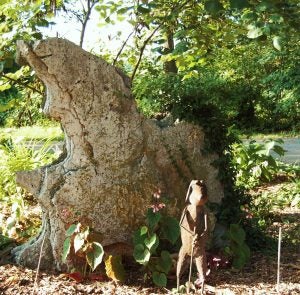
Photo by Andrea Perkins
Andrea Perkins, a member of the Garden Club of Danville, inherited this beautiful rock when she and her husband bought their home on Herrington Lake. It was probably unearthed when the foundations of the house were dug. She took advantage of the find by trimming back the vines, planting perennial begonias, and placing a whimsical metal dog at its base. Whether she realized it or not, Andrea was practicing wabi-sabi gardening.
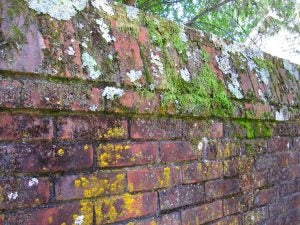
Photo by Susan Jonas
An old brick wall becomes a canvas for an impressionist painting by Mother Nature using lichens, algae, and moss. The wabi-sabi gardener makes no attempt to clean the wall, but appreciates the beauty of aging and decay.
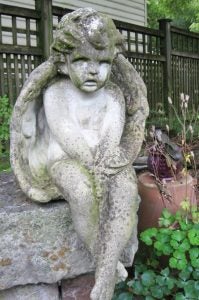
Photo by Susan Jonas.
This statue of a cherub has been allowed to age naturally and develop a beautiful patina after many years in the garden. Observing the effects of time and the elements on natural and manmade objects is part of the wabi-sabi appeal.






